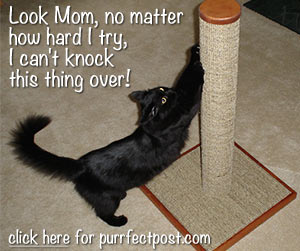Psychogenic Alopecia in Cats
 Psychogenic alopecia in cats is a condition of excessive grooming.
Psychogenic alopecia in cats is a condition of excessive grooming.
What Is Psychogenic Alopecia in Cats?
Cats usually spend 5%-25% of their waking time grooming. Excessive grooming occurs when the grooming behavior takes precedence over other activities, with no apparent goal. Feline psychogenic alopecia and feline hyperesthesia syndrome are two interesting and often overlapping syndromes of cats. Psychogenic alopecia means “hair loss having a psychological or emotional origin.” It may escalate to, or be complicated by, feline hyperesthesia syndrome.Signs of Feline Psychogenic Alopecia
The hair loss in feline psychogenic alopecia is usually symmetrical in distribution and typically found over the trunk, belly, inner thighs, groin, or the rump. Sometimes cats lick themselves bald; other times stubby, broken hairs remain. Cats lick, bite, chew, or pluck at the hair. The skin itself may look normal or it may become red and irritated. You may notice your cat producing more hairballs, or your cat might become constipated from taking in the excess hair. Some cats may hide their excessive grooming behavior from you and are known as “closet lickers.”
Causes of Psychogenic Alopecia in Cats
Stress in your cat’s life can provoke excessive grooming. This usually involves a change in your cat’s environment such as:
- A new home
- A change in the family's schedule
- The addition or subtraction of a family member, including other animals
- Aggression among cats in the household
- Furniture that's been moved around
- Noise or upheaval in the home such as what occurs during home remodeling
- Seeing a new animal outside
- Boredom or frustration
You may be unaware of other stressors in your cat’s life. Self-grooming behavior relaxes cats, so when they become anxious, they may over-groom. Over time, the behavior becomes a habit-forming self-perpetuating cycle, and can then be unrelated to the environmental or internal stressors. It evolves into a type of compulsive behavior and may progress to extreme self-mutilation and self-aggression, signs often seen in feline hyperesthesia syndrome. It is a self-reinforcing behavior, involving the release of endorphins (happy hormones).
Diagnosis of Psychogenic Alopecia in Cats
There is no diagnostic test for psychogenic alopecia. It is diagnosed by excluding other diseases, especially those of the skin, which may include:
- Flea allergy
- Other allergic diseases (contact, inhalant / atopy, bacterial hypersensitivity, food allergy)
- Presence of parasites such as fleas, mites, or lice
- Fungal infections such as ringworm
- Bacterial infections
- Skin cancer
- Pain in the tissues underlying the area being over-groomed
Your veterinarian will perform a complete physical examination and include a variety of diagnostic tests in the workup. These tests might include:
- Examining the hairs under a microscope (broken hairs mean the hair loss is self-induced)
- Complete blood testing
- Skin scraping
- Fungal culture
- Flea combing
- Allergy testing
- Hypoallergenic food trial
- Examining and emptying the anal sacs
- Skin biopsy
- X-rays to rule out potential sources of pain
Medications and diet trials are used to eliminate external parasites and food allergies as causes. Many times, an underlying skin disease may initially lead to the excessive grooming, which then turns into a habitual and compulsive behavior, complicating the picture. If all of the diseases are ruled out or have been properly treated, then psychogenic alopecia may be diagnosed by exclusion.
Treatment of Psychogenic Alopecia in Cats
Psychogenic alopecia is treated by decreasing stress in your cat’s life. This includes behavior modification, increasing playtime with your cat, and decreasing his boredom by enriching his environment with stimulating activities.
Ignoring your cat's excessive grooming behavior is important, especially if he is seeking attention with this behavior because giving him attention will inadvertently reward the over-grooming behavior. Sometimes, engaging the cat in other behaviors such as feeding or playtime before he begins another bout of grooming might be helpful. Do not punish his behavior. This might increase his anxiety and thus increase the over-grooming behavior.
Your veterinarian might suggest trying protective collars (Elizabethan collars), or bad-tasting sprays or gels while trying to break this habit.
If the problem is thought to be due to social stressors, it might help to offer the kitty escape routes such as perches, cubbies, and hiding tents so he can escape torment by other cats in the household. Separating him from the offending cats may be very helpful. It is reported that extra attention and play of at least 10 minutes twice daily can be a useful strategy in some cats.
Sometimes, anti-anxiety or anti-depressant medications are necessary and will be prescribed by your veterinarian. These drugs are usually given for about 12 weeks, or until the symptoms decrease. Then they are slowly tapered down. Some cats may not be able to taper off the drugs and will require them indefinitely. Your veterinarian will monitor blood tests to check for medication side effects. Many of these drugs, though widely prescribed, are not specifically approved for this syndrome in this species, so your permission is required.
Never give your cat any medications without talking to your veterinarian first. Doing so could be harmful and even potentially fatal for your cat.
Your veterinarian may also refer your cat to a behavior specialist. In addition, therapies such as homeopathy may be helpful.
You May Also Like These Articles:
Alternative and Holistic Veterinary Medicine for Cats
Cat Fleas: Does My Cat Have Fleas?
Notice: Ask-a-Vet is an affiliated service for those who wish to speak with a veterinary professional about their pet's specific condition. Initially, a bot will ask questions to determine the general nature of your concern. Then, you will be transferred to a human. There is a charge for the service if you choose to connect to a veterinarian. Ask-a-Vet is not manned by the staff or owners of CatHealth.com, and the advice given should not delay or replace a visit to your veterinarian.






